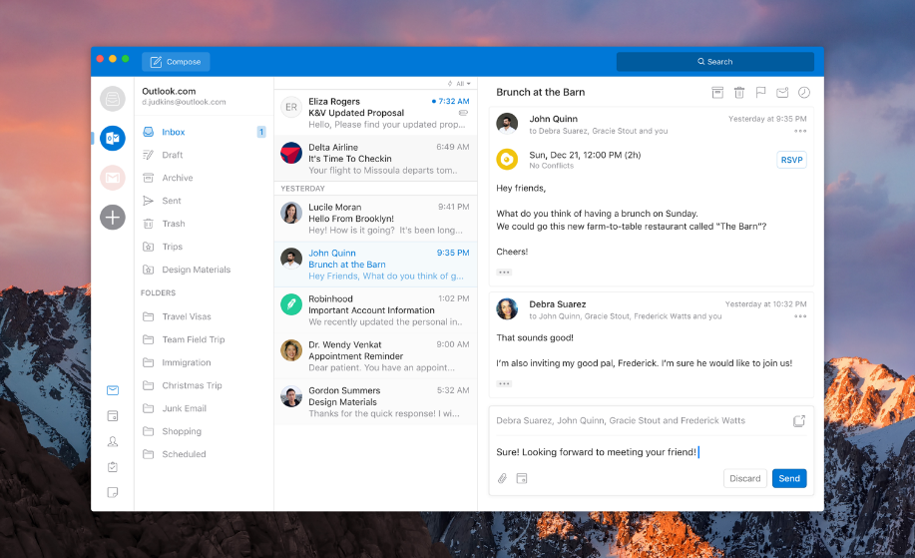Technology-instructional Outlook Client For Mac
Step One Open your Outlook client and click on “Calendar” at the bottom-left corner of your screen Step Two Right-click on “My Calendars” Step Three Click on “Add Calendar” and then on “From Address Book” Step Four Type the name of the person whose calendar you want to see. When found in the address book, click on “Calendar -” button and then on “OK” Step Five You will be able to see the person’s calendar.
It will also appear under “My Calendars”. You will be able to enable or disable the view by checking and un-checking the box next to the person’s name Contact Desktop Support: (415) 405-5562, atdesk@sfsu.edu, LIB 220.
Hi, Not sure if this issue is directly related to the Outlook 2016 for Mac client, but all our users who have Shared Mailboxes add in their Outlook Mac client, these mailboxes DO NOT automatically receive email - the user has to manually click the 'send & receive' button. Our users add the Shared Mailbox as a separate account using their own credentials. We prefer this method of adding Shared Mailbox as it appears in Outlook client as a totally separate mailbox.

For the user's own mailbox, it automatically receives email as you'd expect. But their Shared Mailbox does not receive email unless the 'send & receive' button is pressed.
Technology-instructional Outlook Client For Mac Os
I've read of other people having similar issue, but the trouble shooting steps were for Outlook on Windows which, disappointingly, is vastly different to the OS X version. The differences between Outlook 2016 Mac and Outlook 2016 Windows are far beyond weird. Another weird example - Outlook 2016 on Mac, you can't open a shared calendar someone has given you privileges of 'Free/Busy only' or 'Full Details'. Can only open a Shared Calendar with permissions of Reviewer or better. You can't approve/deny group emails in Outlook 2016 Mac.
You can't view the full list of the GAL in Outlook 2016 Mac. The list goes on and on. Whether Microsoft purposely hamper the Outlook experience on Mac as some sort of sly attempt to win people back over to their Windows platform wouldn't surprise me.
Anyway, in regards to the original topic, it's a bug in Outlook 2016 Mac and Microsoft will fix it sometime in the (distant) future. Shared mailboxes can't be set up on mobile devices, and they don't use a password. They're delegated to licensed users, so there's no charge for them, and access control is handled by the delegated users' accounts. I'd try setting up a separate paid account for them, then set up a transport rule in Exchange admin (mail flow rules) to somehow block or re-route outgoing messages. You could try: Apply this rule if: 'Sender is. Fieldusers@domain.com' Do the following: 'Forward the message for approval' to a shared mailbox, or to a distribution group with an Outlook rule to route those into a folder. Point being any sent messages from the field guys get held internally instead of relayed outside the company.

Thanks for your replies. We're using 365 (Exchange Online) and Outlook 2016 Mac. We're using Shared Mailboxes as a whole separate account. We don't use Shared Mailboxes via the delegates method (although i have tried this and can confirm it does work). We prefer Shared Mailbox as a separate account because it has its own inbox similar to your own account, whereas the delegate method, the Shared Mailbox's inbox is below all the folders of your main account. We are using the method: ' Add an additional Exchange account by using your own credentials:' as per this link. I don't understand what you mean by 'We prefer Shared Mailbox as a separate account.'
Caveat: I am using Windows with Office 365 Business Essentials and Office 365 Business Premium. Maybe 'Exchange Online' does not have the same features.
I used the Office 365 EAC to set up a shared mailbox, I assigned the desired users to it, and it shows up in Outlook at the bottom just like any real additional account. It shows up automatically. The only manual thing I did was add a registry entry to each computer to make Outlook store its Sent Items in the shared mailbox rather than the users own mailbox Sent Items folder. The differences between Outlook 2016 Mac and Outlook 2016 Windows are far beyond weird. Another weird example - Outlook 2016 on Mac, you can't open a shared calendar someone has given you privileges of 'Free/Busy only' or 'Full Details'. Can only open a Shared Calendar with permissions of Reviewer or better.
You can't approve/deny group emails in Outlook 2016 Mac. You can't view the full list of the GAL in Outlook 2016 Mac. The list goes on and on. Whether Microsoft purposely hamper the Outlook experience on Mac as some sort of sly attempt to win people back over to their Windows platform wouldn't surprise me.
Anyway, in regards to the original topic, it's a bug in Outlook 2016 Mac and Microsoft will fix it sometime in the (distant) future.